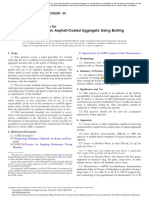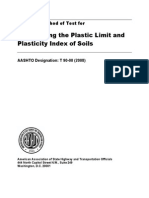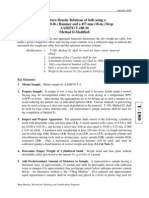Aashto T 267-86 (2018)
Aashto T 267-86 (2018)
Uploaded by
Maricel NgaganCopyright:
Available Formats
Aashto T 267-86 (2018)
Aashto T 267-86 (2018)
Uploaded by
Maricel NgaganOriginal Title
Copyright
Available Formats
Share this document
Did you find this document useful?
Is this content inappropriate?
Copyright:
Available Formats
Aashto T 267-86 (2018)
Aashto T 267-86 (2018)
Uploaded by
Maricel NgaganCopyright:
Available Formats
Standard Method of Test for
Determination of Organic Content
in Soils by Loss on Ignition
AASHTO Designation: T 267-86 (2018)
Technical Subcommittee: 1a, Soil and Unbound Recycled
Materials
Release: Group 3 (July)
American Association of State Highway and Transportation Officials
444 North Capitol Street N.W., Suite 249
Washington, D.C. 20001
Standard Method of Test for
Determination of Organic Content
in Soils by Loss on Ignition
AASHTO Designation: T 267-86 (2018)
Technical Subcommittee: 1a, Soil and Unbound
Recycled Materials
Release: Group 3 (July)
1. SCOPE
1.1. The Loss on Ignition method for the determination of organic content is most applicable to those
materials identified as peats, organic mucks, and soils containing relatively undecayed or
undecomposed vegetative matter or fresh plant materials such as wood, roots, or grass, or
carbonaceous materials such as lignite, coal, etc. This method determines the quantitative
oxidation of organic matter in these materials and gives a valid estimate of organic content. The
Wet Combustion method (T 194) is recommended when it is desired to determine the percentage
of humus-like, easily oxidized organic material to provide information relating to the suitability of
a soil for plant growth.
1.2. The following applies to all specified limits in this standard: For the purposes of determining
conformance with these specifications, an observed value or a calculated value shall be rounded
off “to the nearest unit” in the last right-hand place of figures used in expressing the limiting
value, in accordance with ASTM E29.
1.3. The values stated in SI units are to be regarded as the standard.
2. REFERENCED DOCUMENTS
2.1. AASHTO Standards:
M 231, Weighing Devices Used in the Testing of Materials
R 58, Dry Preparation of Disturbed Soil and Soil–Aggregate Samples for Test
T 194, Determination of Organic Matter in Soils by Wet Combustion
2.2. ASTM Standard:
E29, Standard Practice for Using Significant Digits in Test Data to Determine Conformance
with Specifications
3. APPARATUS
3.1. Oven—Drying oven capable of maintaining temperatures of 110 ± 5°C (230 ± 9°F). Gravity,
instead of blower convection, may be necessary when drying lightweight material.
3.2. Balance—The balance shall have sufficient capacity and conform to M 231, Class G 1.
TS-1a T 267-1 AASHTO
© 2019 by the American Association of State Highway and Transportation Officials.
All rights reserved. Duplication is a violation of applicable law.
3.3. Muffle Furnace—The furnace shall be capable of maintaining a continuous temperature of
455 ± 10°C (833 ± 18°F) and have a combustion chamber capable of accommodating the
designated container and sample. A pyrometer recorder shall indicate the temperature while in use.
3.4. Crucibles or Evaporating Dishes—High silica, alundum, porcelain, or nickel crucibles of 30- to
50-mL capacity or Coors porcelain evaporating dishes, approximately 100-mm top diameter.
3.5. Desiccator—A desiccator of sufficient size containing an effective desiccant.
3.6. Containers—Suitable rustproof metal, porcelain, glass, or plastic-coated containers.
3.7. Miscellaneous Supplies—Asbestos gloves, tongs, spatulas, etc.
4. SAMPLE PREPARATION
4.1. A representative sample with a mass of at least 100 g shall be taken from the thoroughly mixed
portion of the material passing the 2.00-mm (No. 10) sieve that has been obtained in accordance
with R 58.
4.2. Place the sample in a container and dry in the oven at 110 ± 5°C (230 ± 9°F) to constant mass.
Remove the sample from the oven, place in the desiccator, and allow to cool.
Note 1—This sample can be allowed to remain in the oven until ready to proceed with the
remainder of the test.
5. IGNITION PROCEDURE
5.1. Select a sample with a mass of approximately 10 to 40 g, place into tared crucibles or porcelain
evaporating dishes, and determine the mass to the nearest 0.01 g.
Note 2—Sample masses for lightweight materials such as peat may be less than 10 g but should
be of sufficient amount to fill the crucible to at least three-quarter depth. A cover may initially be
required over the crucible during the initial phase of ignition to decrease the possibility of the
sample being “blown out” from the container.
5.2. Place the crucible or dish containing the sample into the muffle furnace for 6 h at a temperature of
455 ± 10°C (833 ± 18°F). Remove the sample from the furnace, place into the desiccator, and
allow to cool.
5.3. Remove the cooled sample from the desiccator and determine the mass to the nearest 0.01 g.
6. CALCULATION
6.1. The organic content shall be expressed as a percentage of the mass of the oven-dried soil and shall
be calculated as follows:
A− B
percent organic matter
= × 100 (1)
A−C
where:
A = mass of crucible or evaporating dish and oven-dried soil, before ignition;
B = mass of crucible or evaporating dish and oven-dried soil, after ignition; and
C = mass of crucible or evaporating dish, to the nearest 0.01 g.
TS-1a T 267-2 AASHTO
© 2019 by the American Association of State Highway and Transportation Officials.
All rights reserved. Duplication is a violation of applicable law.
6.2. Calculate the percentage of organic content to the nearest 0.1 percent.
7. KEYWORDS
7.1. Combustion method; organic content; plant growth; topsoil.
TS-1a T 267-3 AASHTO
© 2019 by the American Association of State Highway and Transportation Officials.
All rights reserved. Duplication is a violation of applicable law.
You might also like
- ASTM D698 Standard Test Methods For Laboratory Compaction Characteristics of Soil Using Standard EffortNo ratings yetASTM D698 Standard Test Methods For Laboratory Compaction Characteristics of Soil Using Standard Effort13 pages
- Sampling Bituminous Paving Mixtures: Standard Practice ForNo ratings yetSampling Bituminous Paving Mixtures: Standard Practice For4 pages
- Standard Specification For Aggregate For Masonry MortarNo ratings yetStandard Specification For Aggregate For Masonry Mortar3 pages
- 2015 - AASHTO T 265-12 Standard Method of Test For Laboratory Determination of Moisture Content of Soils100% (2)2015 - AASHTO T 265-12 Standard Method of Test For Laboratory Determination of Moisture Content of Soils3 pages
- AASHTO T84 Standard Method of Test For Specific Gravity and AbsorptionNo ratings yetAASHTO T84 Standard Method of Test For Specific Gravity and Absorption11 pages
- Minimum Requirements For Agencies Testing and Inspecting Road and Paving MaterialsNo ratings yetMinimum Requirements For Agencies Testing and Inspecting Road and Paving Materials7 pages
- Moisture-Density (Unit Weight) Relations of Soil-Cement Mixtures100% (1)Moisture-Density (Unit Weight) Relations of Soil-Cement Mixtures7 pages
- Evaluating, Selecting, and Specifying Balances and Standard Masses For Use in Soil, Rock, and Construction Materials TestingNo ratings yetEvaluating, Selecting, and Specifying Balances and Standard Masses For Use in Soil, Rock, and Construction Materials Testing6 pages
- Determining The Rheological Properties of Asphalt Binder Using A Dynamic Shear RheometerNo ratings yetDetermining The Rheological Properties of Asphalt Binder Using A Dynamic Shear Rheometer16 pages
- ASTM D 546 Sieve Analysis of Mineral Filler For Bituminous Paving Mixtures100% (1)ASTM D 546 Sieve Analysis of Mineral Filler For Bituminous Paving Mixtures2 pages
- ASTM D3625 Effects of Water On Asphalt Coated Aggregate Using Boiling MethodNo ratings yetASTM D3625 Effects of Water On Asphalt Coated Aggregate Using Boiling Method2 pages
- Compressive Strength of Bituminous Mixtures: Standard Test Method ForNo ratings yetCompressive Strength of Bituminous Mixtures: Standard Test Method For5 pages
- Amount of Water Required For Normal Consistency of Hydraulic Cement PasteNo ratings yetAmount of Water Required For Normal Consistency of Hydraulic Cement Paste3 pages
- Standard Practice For Reducing Samples of Aggregate To Testing Size100% (1)Standard Practice For Reducing Samples of Aggregate To Testing Size7 pages
- ASTM D5581 Resistance To Plastic Flow of Bituminous Mixtures Using MarshallNo ratings yetASTM D5581 Resistance To Plastic Flow of Bituminous Mixtures Using Marshall5 pages
- Unit Weight and Voids in Aggregate: Standard Method of Test ForNo ratings yetUnit Weight and Voids in Aggregate: Standard Method of Test For4 pages
- Density of Soil and Rock In-Place at Depths Below Surface by Nuclear MethodsNo ratings yetDensity of Soil and Rock In-Place at Depths Below Surface by Nuclear Methods7 pages
- ASTM D1461 (1994) - Moisture or Volatile Distillates in Bituminous Paving MixturesNo ratings yetASTM D1461 (1994) - Moisture or Volatile Distillates in Bituminous Paving Mixtures5 pages
- Moisture-Density Relations of Soils Using A 4.54-kg (10-lb.) Rammer and A 457-mm (18-In.) Drop AASHTO T-180-10 (Method D-Modified)100% (1)Moisture-Density Relations of Soils Using A 4.54-kg (10-lb.) Rammer and A 457-mm (18-In.) Drop AASHTO T-180-10 (Method D-Modified)3 pages
- Determining Demulsibility of Emulsified Asphalt: Standard Test Method ForNo ratings yetDetermining Demulsibility of Emulsified Asphalt: Standard Test Method For2 pages
- Sieve Analysis of Mineral Filler For Asphalt Paving MixturesNo ratings yetSieve Analysis of Mineral Filler For Asphalt Paving Mixtures2 pages
- T 134 Moisture Density Relations of Soil-Cement MixturesNo ratings yetT 134 Moisture Density Relations of Soil-Cement Mixtures9 pages
- Preparation of Bituminous Mixture Test Specimens by Means of California Kneading Compactor100% (1)Preparation of Bituminous Mixture Test Specimens by Means of California Kneading Compactor4 pages
- C490 Practice For Use of Apparatus For The Determination ofNo ratings yetC490 Practice For Use of Apparatus For The Determination of5 pages
- Calibration of Laboratory Mechanical-Rammer Soil Compactors: Standard Practices ForNo ratings yetCalibration of Laboratory Mechanical-Rammer Soil Compactors: Standard Practices For6 pages
- Particle-Size Distribution (Gradation) of Soils Using Sieve AnalysisNo ratings yetParticle-Size Distribution (Gradation) of Soils Using Sieve Analysis34 pages
- Torsional Ring Shear Test To Determine Drained Residual Shear Strength of Cohesive Soils100% (1)Torsional Ring Shear Test To Determine Drained Residual Shear Strength of Cohesive Soils7 pages
- A5TM D 2974 87 Standard Test Methods ForNo ratings yetA5TM D 2974 87 Standard Test Methods For3 pages
- Stas American Astm d2974-87 Material OrganicNo ratings yetStas American Astm d2974-87 Material Organic3 pages
- Encyclopaedia Britannica, 11th Edition, Volume 8, Slice 3 "Destructors" to "Diameter"From EverandEncyclopaedia Britannica, 11th Edition, Volume 8, Slice 3 "Destructors" to "Diameter"No ratings yet
- Natural Gas: Consumers and Consuming Industry: A Handbook for Students of the Natural Gas IndustryFrom EverandNatural Gas: Consumers and Consuming Industry: A Handbook for Students of the Natural Gas IndustryNo ratings yet
- Field Guide: Fire in Dry Eucalypt Forest: Fuel Assessment and Fire Behaviour Prediction in Dry Eucalypt ForestFrom EverandField Guide: Fire in Dry Eucalypt Forest: Fuel Assessment and Fire Behaviour Prediction in Dry Eucalypt ForestNo ratings yet
- Autoclave Expansion of Hydraulic Cement: Standard Test Method ForNo ratings yetAutoclave Expansion of Hydraulic Cement: Standard Test Method For4 pages
- Slump of Hydraulic-Cement Concrete: Standard Test Method ForNo ratings yetSlump of Hydraulic-Cement Concrete: Standard Test Method For4 pages
- Design and Analysis of Indexing Cam Mechanism WithNo ratings yetDesign and Analysis of Indexing Cam Mechanism With11 pages
- 6.6 KW High-Frequency Full-Bridge LLC DC/DC Converter With Sic MosfetsNo ratings yet6.6 KW High-Frequency Full-Bridge LLC DC/DC Converter With Sic Mosfets6 pages
- Instructor Resources: Crystal Violet Colorimetry: A Beer's Law InvestigationNo ratings yetInstructor Resources: Crystal Violet Colorimetry: A Beer's Law Investigation10 pages
- 2019 AW (Summer) Sem III Mathematics IIINo ratings yet2019 AW (Summer) Sem III Mathematics III3 pages
- Board of Intermediate Education, A.P, HyderabadNo ratings yetBoard of Intermediate Education, A.P, Hyderabad2 pages
- Coordinate Geometry Exercises and SolutionsNo ratings yetCoordinate Geometry Exercises and Solutions28 pages
- Validation of The Spanish of The Problem Areas in Diabetes (PAID-SP) ScaleNo ratings yetValidation of The Spanish of The Problem Areas in Diabetes (PAID-SP) Scale3 pages
- Movement in & Out of Cells (Multiple Choice) 1 QPNo ratings yetMovement in & Out of Cells (Multiple Choice) 1 QP13 pages
- Solenoid Valves 2/2 210: Pilot Operated Hung Diaphragm 3/8 To 1 1/2No ratings yetSolenoid Valves 2/2 210: Pilot Operated Hung Diaphragm 3/8 To 1 1/22 pages
- ASTM D698 Standard Test Methods For Laboratory Compaction Characteristics of Soil Using Standard EffortASTM D698 Standard Test Methods For Laboratory Compaction Characteristics of Soil Using Standard Effort
- Sampling Bituminous Paving Mixtures: Standard Practice ForSampling Bituminous Paving Mixtures: Standard Practice For
- Standard Specification For Aggregate For Masonry MortarStandard Specification For Aggregate For Masonry Mortar
- 2015 - AASHTO T 265-12 Standard Method of Test For Laboratory Determination of Moisture Content of Soils2015 - AASHTO T 265-12 Standard Method of Test For Laboratory Determination of Moisture Content of Soils
- AASHTO T84 Standard Method of Test For Specific Gravity and AbsorptionAASHTO T84 Standard Method of Test For Specific Gravity and Absorption
- Minimum Requirements For Agencies Testing and Inspecting Road and Paving MaterialsMinimum Requirements For Agencies Testing and Inspecting Road and Paving Materials
- Moisture-Density (Unit Weight) Relations of Soil-Cement MixturesMoisture-Density (Unit Weight) Relations of Soil-Cement Mixtures
- Evaluating, Selecting, and Specifying Balances and Standard Masses For Use in Soil, Rock, and Construction Materials TestingEvaluating, Selecting, and Specifying Balances and Standard Masses For Use in Soil, Rock, and Construction Materials Testing
- Determining The Rheological Properties of Asphalt Binder Using A Dynamic Shear RheometerDetermining The Rheological Properties of Asphalt Binder Using A Dynamic Shear Rheometer
- ASTM D 546 Sieve Analysis of Mineral Filler For Bituminous Paving MixturesASTM D 546 Sieve Analysis of Mineral Filler For Bituminous Paving Mixtures
- ASTM D3625 Effects of Water On Asphalt Coated Aggregate Using Boiling MethodASTM D3625 Effects of Water On Asphalt Coated Aggregate Using Boiling Method
- Compressive Strength of Bituminous Mixtures: Standard Test Method ForCompressive Strength of Bituminous Mixtures: Standard Test Method For
- Amount of Water Required For Normal Consistency of Hydraulic Cement PasteAmount of Water Required For Normal Consistency of Hydraulic Cement Paste
- Standard Practice For Reducing Samples of Aggregate To Testing SizeStandard Practice For Reducing Samples of Aggregate To Testing Size
- ASTM D5581 Resistance To Plastic Flow of Bituminous Mixtures Using MarshallASTM D5581 Resistance To Plastic Flow of Bituminous Mixtures Using Marshall
- Unit Weight and Voids in Aggregate: Standard Method of Test ForUnit Weight and Voids in Aggregate: Standard Method of Test For
- Density of Soil and Rock In-Place at Depths Below Surface by Nuclear MethodsDensity of Soil and Rock In-Place at Depths Below Surface by Nuclear Methods
- ASTM D1461 (1994) - Moisture or Volatile Distillates in Bituminous Paving MixturesASTM D1461 (1994) - Moisture or Volatile Distillates in Bituminous Paving Mixtures
- Moisture-Density Relations of Soils Using A 4.54-kg (10-lb.) Rammer and A 457-mm (18-In.) Drop AASHTO T-180-10 (Method D-Modified)Moisture-Density Relations of Soils Using A 4.54-kg (10-lb.) Rammer and A 457-mm (18-In.) Drop AASHTO T-180-10 (Method D-Modified)
- Determining Demulsibility of Emulsified Asphalt: Standard Test Method ForDetermining Demulsibility of Emulsified Asphalt: Standard Test Method For
- Sieve Analysis of Mineral Filler For Asphalt Paving MixturesSieve Analysis of Mineral Filler For Asphalt Paving Mixtures
- T 134 Moisture Density Relations of Soil-Cement MixturesT 134 Moisture Density Relations of Soil-Cement Mixtures
- Preparation of Bituminous Mixture Test Specimens by Means of California Kneading CompactorPreparation of Bituminous Mixture Test Specimens by Means of California Kneading Compactor
- C490 Practice For Use of Apparatus For The Determination ofC490 Practice For Use of Apparatus For The Determination of
- Calibration of Laboratory Mechanical-Rammer Soil Compactors: Standard Practices ForCalibration of Laboratory Mechanical-Rammer Soil Compactors: Standard Practices For
- Particle-Size Distribution (Gradation) of Soils Using Sieve AnalysisParticle-Size Distribution (Gradation) of Soils Using Sieve Analysis
- Torsional Ring Shear Test To Determine Drained Residual Shear Strength of Cohesive SoilsTorsional Ring Shear Test To Determine Drained Residual Shear Strength of Cohesive Soils
- Encyclopaedia Britannica, 11th Edition, Volume 8, Slice 3 "Destructors" to "Diameter"From EverandEncyclopaedia Britannica, 11th Edition, Volume 8, Slice 3 "Destructors" to "Diameter"
- Natural Gas: Consumers and Consuming Industry: A Handbook for Students of the Natural Gas IndustryFrom EverandNatural Gas: Consumers and Consuming Industry: A Handbook for Students of the Natural Gas Industry
- Field Guide: Fire in Dry Eucalypt Forest: Fuel Assessment and Fire Behaviour Prediction in Dry Eucalypt ForestFrom EverandField Guide: Fire in Dry Eucalypt Forest: Fuel Assessment and Fire Behaviour Prediction in Dry Eucalypt Forest
- Autoclave Expansion of Hydraulic Cement: Standard Test Method ForAutoclave Expansion of Hydraulic Cement: Standard Test Method For
- Slump of Hydraulic-Cement Concrete: Standard Test Method ForSlump of Hydraulic-Cement Concrete: Standard Test Method For
- Design and Analysis of Indexing Cam Mechanism WithDesign and Analysis of Indexing Cam Mechanism With
- 6.6 KW High-Frequency Full-Bridge LLC DC/DC Converter With Sic Mosfets6.6 KW High-Frequency Full-Bridge LLC DC/DC Converter With Sic Mosfets
- Instructor Resources: Crystal Violet Colorimetry: A Beer's Law InvestigationInstructor Resources: Crystal Violet Colorimetry: A Beer's Law Investigation
- Validation of The Spanish of The Problem Areas in Diabetes (PAID-SP) ScaleValidation of The Spanish of The Problem Areas in Diabetes (PAID-SP) Scale
- Solenoid Valves 2/2 210: Pilot Operated Hung Diaphragm 3/8 To 1 1/2Solenoid Valves 2/2 210: Pilot Operated Hung Diaphragm 3/8 To 1 1/2





























































































